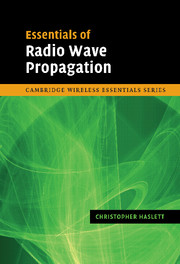Book contents
- Frontmatter
- Contents
- Preface
- Acknowledgements
- 1 Propagation in free space and the aperture antenna
- 2 Point-to-area transmission
- 3 The effect of obstacles
- 4 Reflection, scatter and penetration
- 5 Estimating the received signal strength in complex environments
- 6 Atmospheric effects
- 7 System design and interference management
- 8 Software-based tools
- 9 Summary
- Appendix 1 The decibel scale
- Appendix 2 Phasor arithmetic and phasor diagrams
- Appendix 3 Formula sheet
- Appendix 4 Explanation of the link budget
- Further reading
- References
- Recommendations of the Radiocommunication Bureau of the International Telecommunications Union (ITU), Geneva
- Author's biography
- Index
4 - Reflection, scatter and penetration
Published online by Cambridge University Press: 09 August 2009
- Frontmatter
- Contents
- Preface
- Acknowledgements
- 1 Propagation in free space and the aperture antenna
- 2 Point-to-area transmission
- 3 The effect of obstacles
- 4 Reflection, scatter and penetration
- 5 Estimating the received signal strength in complex environments
- 6 Atmospheric effects
- 7 System design and interference management
- 8 Software-based tools
- 9 Summary
- Appendix 1 The decibel scale
- Appendix 2 Phasor arithmetic and phasor diagrams
- Appendix 3 Formula sheet
- Appendix 4 Explanation of the link budget
- Further reading
- References
- Recommendations of the Radiocommunication Bureau of the International Telecommunications Union (ITU), Geneva
- Author's biography
- Index
Summary
When a radio wave can reach a receiver by more than one route, we say that the receiver is in a multipath environment. The way in which a standing wave pattern is established when the received signal is the combination of both a direct and a reflected signal is explained. The characteristics of the standing wave are shown to depend upon the nature of the reflection as determined by its reflection coefficient. Further examples of propagation paths involving reflection include propagation over a flat plane and propagation over water, the latter having the additional complication of tidal variation often causing the position of the reflecting surface to change. The more complex situation that arises when there are many different routes from transmitter to receiver is analysed. It is seen that the nature of the standing wave depends on whether one of the contributing paths is dominant (the ‘Rician’ environment) or whether the strengths of all of the signals on all paths are about equal (the ‘Rayleigh’ environment). It is further shown that the reflected signal depends on whether the reflecting surface is smooth or rough and the difference in the nature of the reflected signal is analysed. A further possible propagation mechanism is that of penetration of materials. The amount of penetration is seen to be dependent upon the electrical characteristics of the material and the frequency of the electromagnetic wave.
Introduction
In practical situations, radio waves will reflect off walls and off the ground.
- Type
- Chapter
- Information
- Essentials of Radio Wave Propagation , pp. 83 - 109Publisher: Cambridge University PressPrint publication year: 2007



